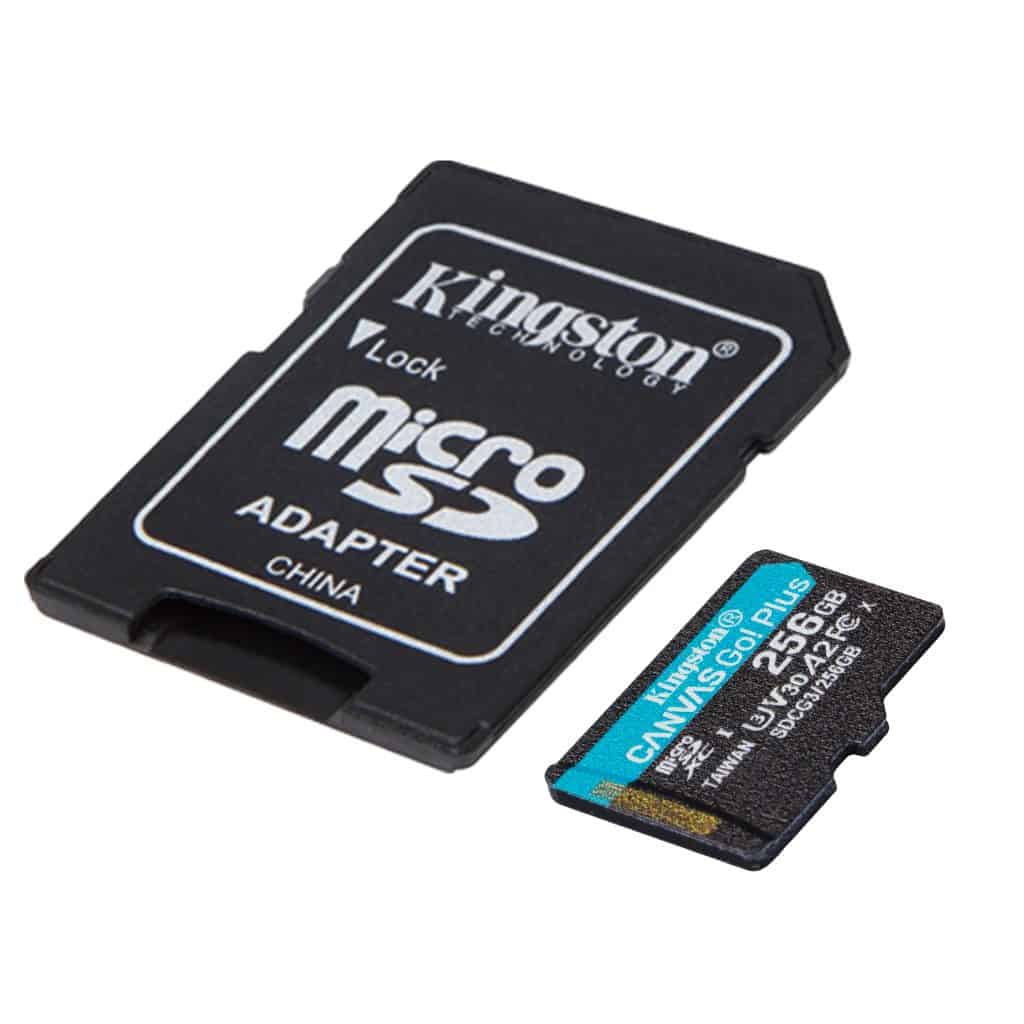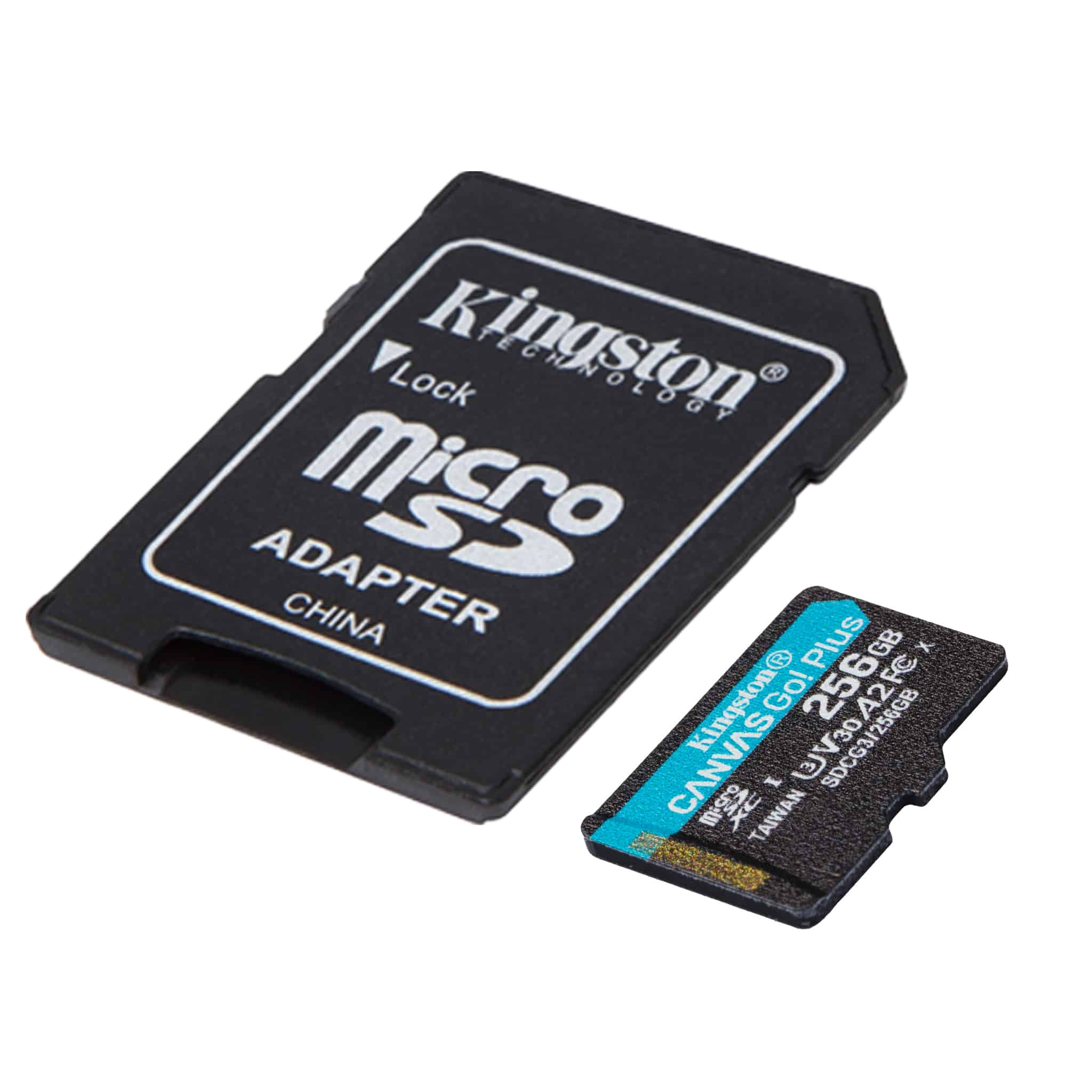Table of Contents
amazon KINGSTON CANVAS GO! PLUS MICROSD 128 GB reviews
The demand for data storage of users is increasing sharply due to the explosion of content such as 4K videos, lossless music, high-resolution photos, heavy graphics games, and large applications. At the same time, new devices such as action cameras, security cameras, drones are also becoming more and more popular.
Most of these devices use microSD memory cards. Understanding that, memory card manufacturers continuously offer memory card models with higher capacity, faster speed to meet the “hungry” needs of users capacity.
The memory card that BiaReview uses in this review is the Kingston Canvas Go! Plus microSD 128GB capacity. In addition to the 128GB option, Canvas Go! Plus also has many other capacities from 64GB to 512GB.
Kingston claims the maximum read speed of this card is 170MB/s, and the maximum write speed is 90MB/s. The card meets Class 10, UHS-I, U3, V30 standards, can record 4K Ultra HD video. Also, Canvas Go! Plus, microSD also supports the A2 application performance standard (A2 Application Performance Class) to speed up working on tablets and smartphones, withstanding temperatures from -25°C to 85°C.
Unboxing and design overview
If you have ever used Kingston memory card products, you will immediately recognize the packaging of Canvas Go! Plus, it is very familiar. Still, a simple white cardboard style with a center area of transparent plastic allows users to look at the main character before “single latch.” Parameters about card capacity, maximum speed, and supporting performance standards are prominently printed in the right corner.
This year, Kingston adds on the packaging an image of a young man carrying a mountain bike in the middle of the jungle. Of course, he didn’t forget to add a GoPro-style action camera on his helmet. Hinting that Canvas Go! Plus be born for these devices.
All types of microSD cards are subject to a common design standard to ensure compatibility between devices, which is why the design of the Kingston Canvas Go! Plus, microSD is not significantly different from other microSD cards on the market. The front of the card is where information about capacity, card type, speed, serial number, and manufacturer is printed, while the back is where the contact pins are located. The information printed on the card is clear and sharp.
Most microSD card models come with an adapter, also known as a card shirt, which “transforms” into an SD card when needed, and so does Kingston’s memory card model. When adding a “card shirt,” you can use Canvas Go! Plus with camera or laptop, card reader easier. The adapter part is also made of sturdy, sturdy plastic with clearly printed information.
Benchmark performance and actual usage
To test the speed of Kingston Canvas Go! Plus 128GB microSD, I inserted this card into the Kingston MobileLite Plus card reader. The card reader also launched with Kingston’s new generation of Canvas Plus memory cards, USB 3.2 Gen 1, UHS-II standard.
The card reader will connect via USB 3.2 Gen 2 Type-A port on Asus ROG Zephyrus M15 laptop with Intel Core i7-10750H configuration, 16GB DDR4 RAM, NVIDIA GeForce GTX 1660 Ti graphics card, M.2 NVMe PCIe SSD 3.0 Kingston KC2500 1TB, Windows 10 Home 20H2.
Kingston Canvas Go! Plus comes preformatted with exFAT, and Windows 10 gets 115 GB of free memory. When inserted into phones like Note 20 Ultra, Galaxy S20 FE, the card shows a total capacity of 116GB, while inserted in Realme 7 and Oppo A93 shows a capacity of 124GB. This difference in capacity is completely normal because the calculation of the manufacturers of storage devices such as memory cards, USB, hard drives is a little different from the calculation of operating systems and manufacturers. Laptops, smartphones.
In the read/write speed test of the Kingston Canvas Go! Plus 128GB, I use the benchmark software Crystal DiskMark, AS SSD Benchmark, ATTO, and Anvil’s Storage Utilities. Besides, I also conduct real testing by performing three file copy tests.
The first test was performed on a 27.5GB MKV video file.
The second test was performed on a 5.36GB photo folder containing 684 JPG files.
The last test uses an 11.7GB music folder containing 488 FLAC files.
The results returned from the Crystal DiskMark software surprised to show Kingston Canvas Go’s read and write speeds! Plus, 128GB comes to 185.39 MB/s and 126.71 MB/s respectively in the sequential file read/write a test (simulating copying or writing files to the card). The lowest is 7.6 MB/s and 4.38 MB/s when testing the random access speed on the card (simulating access to applications installed scattered on the card or when going back and forth when watching movies, listening to music). That is a result that is even higher than Kingston’s claim (170MB/s read, and 90MB/s write).
The results measured by AS SSD Benchmark are said to reflect more accurately than Crystal Disk Mark because of using incompressible data instead of compressing, so the speed will be lower. Canvas Go’s current reading speed! Plus reached 161.26MB/s, and the write speed reached 126.76 MB/s. Thus, the read speed decreased slightly but was still relatively close to the published level, while the write speed was equivalent to when measured with Crystal Disk Mark.
AS SSD also has another tool, Compression Benchmark, which measures the data compression speed of memory cards with compression levels from 0% to 100%. In theory, this ideal result should be as straight and as high as possible, indicating the card’s stability. Kingston Canvas Go! Plus, 128GB did not “discontinuity” at all in the entire test process. The write speed graph (red) ranges from about 111MB/s to 136MB/s. While the blue line, which represents an almost straight read data rate, shows a high stability at about 161MB/s.
Another useful tool in AS SSD is the Copy Benchmark, which measures the card’s speed when copying other data types such as ISO files, application installation files, and game files. In these tests, Canvas Go! Plus performed best when copying ISO files at 120.34 MB/s. With the application installation file, the copy speed decreased to 42.32MB / s, and with the game file, the speed reached 85.36MB / s.
ATTO Disk Benchmark is an old but still trusted tool that allows users to monitor card performance in detail in various data size options. BiaReview set the drive to access 256MB of data in this test, with file sizes from 512B to 64MB. Canvas Go! Plus has the highest speed of 127.57MB/s for write and 160.5MB/s for reading.
Anvil’s Storage Utilities test is more reference when the secondary indicators are measured quite carefully; the sample samples are also more diverse, giving users a more comprehensive view of the product, including response time, IOPS. With this test, Kingston Canvas Go! Plus reached 162MB/s read and 127.76MB/s write.
In the actual test, when copying files from the computer to the memory card to test the card’s write speed. In the first test with a 27.5GB MKV video file, the recording speed was stable at about 127MB/ S. With the second test, performed on a 5.36GB photo folder containing 684 JPG files, the speed is stable 105MB/s. With the last test using an 11.7GB music folder containing 488 FLAC files, the stable speed is about 116MB/s.
Still in the actual test, when copying files from the memory card to the computer to check the read speed of the card, in the first test with video files, the initial speed was up to 175MB/s, but after about 3GB initially dropped to 90MB/s and stabilized back to 160MB/s in later GBs. With the music folder copy test, the speed is stable at about 154 – 158MB/s. In the last test with the image folder, the speed is stable at 153MB/s.
I have also conducted 4K video recording, high-resolution continuous photography on this card, and installed games and applications on the card, and they all work well. During the test, the card worked stably, without any lag.
Summary
Through the above tests, it can be seen that Kingston Canvas Go! Plus, microSD 128GB has very good performance. The actual write speed of the card is very high, ranging from 105 to 127 MB/s, even higher than the 90MB/s specification announced by the manufacturer in many cases. Actual read speeds from 153 to 160MB/s are also very close to the 170MB/s that Kingston claims.
With up to 128GB of storage, Kingston Canvas Go! Plus, microSD is a valuable solution for users with great needs for storing heavy data such as movies, good quality videos, high-resolution photos, installing many games or applications. Good read/write speeds, lifetime warranty, and free technical support are also factors that ensure the quality of the memory card from Kingston.
If you want to save money, users can also choose lower capacities like 64GB for only about $30. However, note that only the 128GB capacity or more has the highest speed, while the 64GB capacity level, the write speed, will be slightly lower, about 70MB/s.
where can you get a KINGSTON CANVAS GO! PLUS MICROSD 128 GB online
Kingston 128GB microSDXC Canvas Go Plus 170MB/s Read UHS-I, C10, U3, V30, A2/A1 Memory Card + Adapter (SDCG3/128GB): Buy it now
Kingston 128GB SDXC Micro Canvas Go! Plus Memory Card & Adapter Works with GoPro Hero 7 Black, Silver, Hero7 White Camera (SDCG3/128GB) Bundle with (1) Everything But Stromboli TF and SD Card Reader: Buy it now
kingston canvas go plus sdxc 128gb uhs-i u3 128 gb v30

